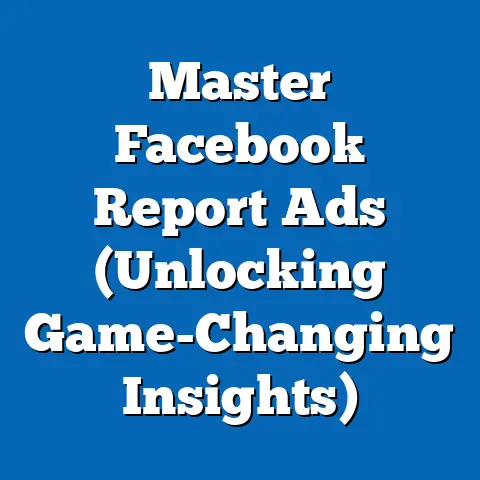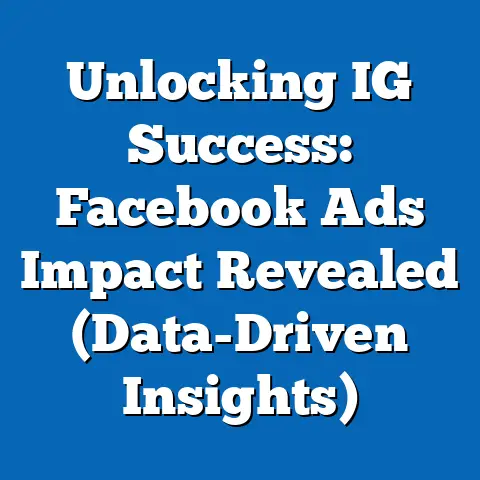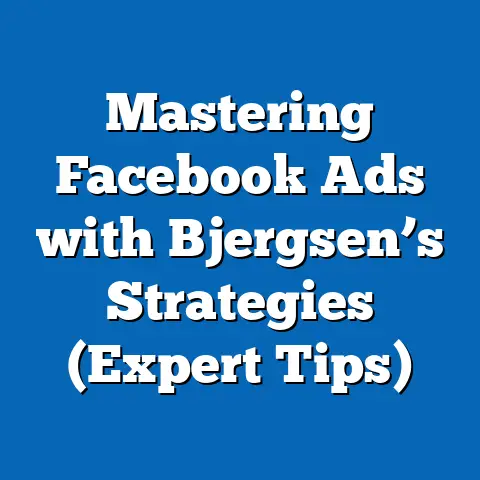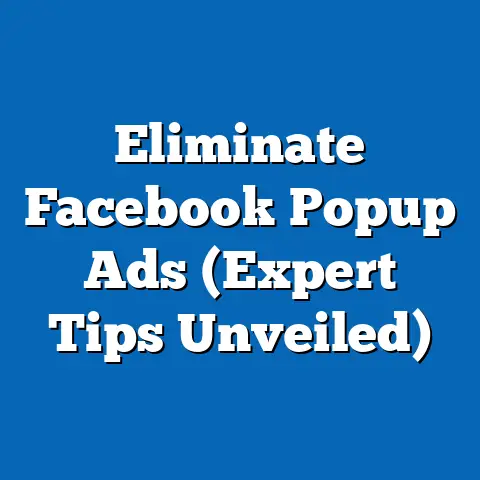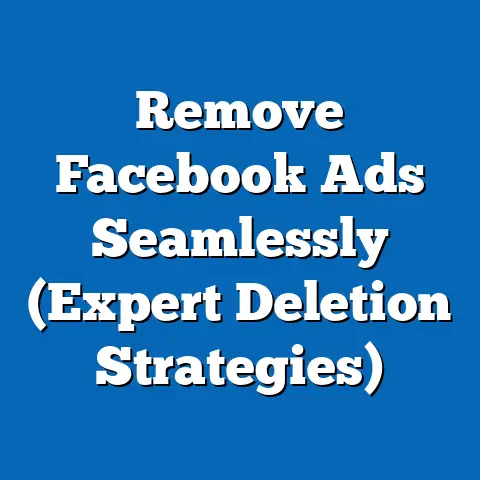Boost Facebook Ads Conversion Rate (Expert Strategies)
The world is waking up. Consumers are increasingly aware of the environmental impact of their choices, and they’re actively seeking out brands that align with their values. This shift has created a boom in the eco-tech sector – a dynamic space where innovation meets sustainability. But having a great product isn’t enough. To truly thrive, eco-tech companies need to effectively reach their target audience and convert them into loyal customers. That’s where Facebook Ads come in.
I’ve spent years helping businesses, including those in the eco-tech space, leverage the power of Facebook advertising. And I can tell you firsthand, it’s not just about throwing money at the platform. It’s about crafting a strategy that speaks directly to the values and motivations of eco-conscious consumers. This means understanding your audience, crafting compelling ad copy, utilizing precise targeting, and constantly optimizing your campaigns. This article dives deep into the world of Facebook Ads conversion rate optimization (CRO) specifically tailored for eco-tech brands. Get ready to learn the expert strategies that will help you turn clicks into customers and drive meaningful impact for your business and the planet.
Section 1: Understanding Facebook Ads for Eco-Tech
Facebook Ads, at their core, are a powerful tool for reaching a massive audience with targeted messaging. With billions of active users, Facebook offers unparalleled reach and sophisticated targeting options, making it a prime platform for businesses of all sizes. But for eco-tech brands, the platform offers something more: the ability to connect with a community of like-minded individuals who are actively seeking sustainable alternatives.
The eco-tech audience is unique. They’re not just looking for the cheapest or most convenient option. They’re motivated by a desire to reduce their environmental footprint, support ethical businesses, and contribute to a more sustainable future. They value transparency, authenticity, and innovation. Understanding these values is crucial for crafting effective Facebook Ads.
Why are Facebook Ads particularly effective for eco-tech brands? Several reasons:
- Targeted Reach: Facebook allows you to target users based on their interests, demographics, behaviors, and even their connections. This means you can pinpoint individuals who are passionate about environmental issues, sustainable living, and specific eco-tech solutions.
- Visual Storytelling: Facebook is a highly visual platform, making it ideal for showcasing the benefits of your eco-tech products through engaging images and videos. You can demonstrate how your products work, highlight their sustainable features, and tell the story behind your brand.
- Community Building: Facebook allows you to create a community around your brand, fostering engagement and loyalty among your customers. You can use Facebook Ads to drive traffic to your page, encourage followers, and participate in relevant conversations.
In fact, a study by Nielsen found that consumers are four times more likely to purchase from a brand that has a strong purpose. This highlights the importance of communicating your brand’s values and mission in your Facebook Ads. By showcasing your commitment to sustainability and ethical practices, you can build trust and credibility with your target audience.
Takeaway: Facebook Ads are a powerful tool for eco-tech brands to connect with their target audience, build community, and drive conversions. Understanding the values and motivations of eco-conscious consumers is crucial for crafting effective campaigns.
Section 2: Crafting Compelling Ad Copy
The key to capturing the attention of eco-conscious consumers on Facebook lies in crafting compelling ad copy that resonates with their values. Gone are the days of generic marketing slogans. Today’s consumers demand authenticity and transparency. Your ad copy needs to clearly communicate your brand’s commitment to sustainability, innovation, and ethical practices.
Here are some expert strategies for writing persuasive ad copy for eco-tech brands:
- Good: “Reduce your carbon footprint with our solar-powered chargers. Shop now and get 10% off!”
- Better: “Power your adventures sustainably! Our solar-powered chargers are made from recycled materials and reduce carbon emissions by 40%. Join the movement and shop now for 10% off!”
The “better” example is more compelling because it highlights the sustainable features of the product, connects with the audience’s values, and includes a clear call to action.
I’ve seen firsthand how powerful storytelling can be in Facebook Ads. One of my clients, an eco-friendly cleaning product company, saw a 30% increase in conversion rates after they started incorporating customer testimonials into their ads. These testimonials highlighted the effectiveness of the products and the positive impact they were having on the environment.
Takeaway: Crafting compelling ad copy is crucial for capturing the attention of eco-conscious consumers. Highlight sustainability, innovation, ethical practices, and use emotional triggers to connect with your audience on a deeper level.
Section 3: Targeting the Right Audience
Even the most compelling ad copy will fall flat if it’s not reaching the right audience. Facebook’s targeting capabilities are incredibly powerful, allowing you to pinpoint your ideal customers based on a wide range of factors. For eco-tech brands, this means identifying individuals who are passionate about environmental issues, sustainable living, and specific eco-tech solutions.
Here’s a breakdown of how to leverage Facebook’s targeting options:
- Demographic Targeting: Target users based on their age, gender, education, income, and other demographic factors. For eco-tech products, you might target younger, more educated individuals who are more likely to be environmentally conscious.
- Geographic Targeting: Target users based on their location. This can be particularly useful for eco-tech products that are relevant to specific regions or communities.
- Interest Targeting: Target users based on their interests, hobbies, and activities. This is where you can really pinpoint your ideal customers. Look for interests like “sustainable living,” “environmental conservation,” “renewable energy,” and specific eco-tech brands or products.
- Behavioral Targeting: Target users based on their online behavior, such as their purchase history, browsing habits, and engagement with specific types of content.
- Custom Audiences: Create custom audiences based on your existing customer data, such as email lists or website visitors. This allows you to target your most engaged customers with personalized ads.
- Lookalike Audiences: Create lookalike audiences based on your custom audiences. This allows you to reach new customers who share similar characteristics with your existing customers.
I once worked with a company that sold electric bikes. They were struggling to generate leads through their Facebook Ads. After analyzing their target audience, we realized they were focusing on broad demographics and interests. We refined their targeting to focus on individuals who were interested in cycling, outdoor recreation, and sustainable transportation. We also created a lookalike audience based on their existing customer data. As a result, they saw a 50% increase in lead generation.
Takeaway: Facebook’s targeting capabilities are essential for reaching your ideal customers. Leverage demographic, geographic, interest, behavioral, custom, and lookalike audiences to maximize your ad reach and improve conversion rates.
Section 4: Design and Visuals that Convert
In the visually driven world of Facebook, your ad’s design and visuals are often the first thing that captures a user’s attention. For eco-tech brands, this is an opportunity to showcase your commitment to sustainability and innovation through visually appealing and engaging content.
Here are some best practices for creating eye-catching visuals that represent eco-tech values:
- Use High-Quality Images and Videos: Invest in professional-quality images and videos that showcase your products in the best possible light.
- Highlight Sustainable Features: Emphasize the sustainable features of your products through visuals. Show how your products are made from recycled materials, reduce waste, or conserve energy.
- Tell a Story: Use visuals to tell the story behind your brand and your commitment to sustainability. Share images of your team working on sustainable initiatives or highlight the positive impact your products are having on the environment.
- Use Video Content: Video content is highly engaging and can be a powerful tool for increasing conversion rates. Create videos that demonstrate how your products work, highlight their sustainable features, or share customer testimonials.
- Keep it Consistent: Ensure your visuals are consistent with your brand’s overall aesthetic and messaging.
For example, an eco-tech brand that sells solar panels might use images of homes powered by solar energy or videos showcasing the installation process. A brand that sells reusable water bottles might use images of people using their bottles in outdoor settings or videos highlighting the environmental impact of single-use plastic bottles.
According to a study by HubSpot, videos on social media generate 1200% more shares than text and images combined. This highlights the power of video content in increasing engagement and reach.
Takeaway: Ad design and visuals are crucial for capturing attention and driving conversions. Use high-quality images and videos that highlight sustainable features, tell a story, and are consistent with your brand’s overall aesthetic.
Section 5: A/B Testing for Continuous Improvement
In the ever-evolving world of Facebook advertising, continuous improvement is key. A/B testing, also known as split testing, is a powerful technique for optimizing your ad performance and maximizing your conversion rates.
A/B testing involves creating two or more versions of your ad and testing them against each other to see which one performs better. You can test a wide range of elements, including:
- Headlines: Test different headlines to see which one captures the most attention and generates the most clicks.
- Images: Test different images to see which one resonates most with your target audience.
- Ad Copy: Test different ad copy to see which one effectively communicates your message and drives conversions.
- Calls to Action: Test different calls to action to see which one encourages users to take the desired action.
- Audience Segments: Test different audience segments to see which one is most responsive to your ads.
Here’s a step-by-step guide on how to implement A/B testing effectively:
- Identify a Variable to Test: Choose one element of your ad to test at a time. This will allow you to isolate the impact of that specific variable.
- Create Two Versions of Your Ad: Create two versions of your ad that are identical except for the variable you are testing.
- Run Your Ads: Run your ads for a specific period of time and track the results.
- Analyze the Results: Analyze the results to see which version of your ad performed better.
- Implement the Winning Version: Implement the winning version of your ad and continue testing other variables.
I worked with an eco-friendly clothing company that was struggling to improve their Facebook Ad conversion rates. We implemented A/B testing and started by testing different headlines. After running the ads for a week, we found that a headline that emphasized the company’s commitment to ethical sourcing performed significantly better than a headline that focused on the product’s features. We implemented the winning headline and continued testing other variables, ultimately resulting in a 20% increase in conversion rates.
Takeaway: A/B testing is essential for optimizing your ad performance and maximizing your conversion rates. Test different elements of your ad, analyze the results, and implement the winning versions to continuously improve your campaigns.
Section 6: Tracking and Measuring Success
Tracking and measuring the success of your Facebook Ads is crucial for understanding what’s working and what’s not. By analyzing the right metrics, you can identify areas for improvement and refine your strategies to maximize your return on investment.
Here are some key metrics that eco-tech brands should focus on:
- Click-Through Rate (CTR): This measures the percentage of people who click on your ad after seeing it. A high CTR indicates that your ad is relevant and engaging to your target audience.
- Conversion Rate: This measures the percentage of people who take the desired action after clicking on your ad, such as making a purchase or filling out a form. A high conversion rate indicates that your ad is effectively driving conversions.
- Cost Per Click (CPC): This measures the cost you pay each time someone clicks on your ad. A low CPC indicates that you are efficiently reaching your target audience.
- Cost Per Conversion (CPC): This measures the cost you pay for each conversion. A low CPA indicates that you are effectively driving conversions at a reasonable cost.
- Return on Ad Spend (ROAS): This measures the revenue you generate for every dollar you spend on advertising. A high ROAS indicates that your ads are generating a significant return on investment.
To accurately measure these metrics, you need to set up Facebook Pixel on your website. Facebook Pixel is a small piece of code that tracks user behavior on your website, allowing you to measure conversions, optimize your ads, and build custom audiences.
In addition to tracking these metrics, it’s also important to analyze the qualitative data you collect from your customers. Read customer reviews, monitor social media conversations, and conduct customer surveys to gain insights into their needs, preferences, and pain points.
By combining quantitative and qualitative data, you can gain a comprehensive understanding of your ad performance and refine your strategies to maximize your ROI.
Takeaway: Tracking and measuring the success of your Facebook Ads is crucial for understanding what’s working and what’s not. Focus on key metrics like CTR, conversion rate, CPC, CPA, and ROAS, and combine quantitative data with qualitative insights to refine your strategies.
Conclusion
Effective Facebook Ads can be a game-changer for eco-tech brands looking to connect with their target audience, build community, and drive conversions. By understanding the values and motivations of eco-conscious consumers, crafting compelling ad copy, utilizing precise targeting, creating visually appealing content, continuously optimizing your campaigns, and tracking your results, you can significantly boost your conversion rates and achieve your business goals.
Remember, the digital landscape is constantly evolving. It’s crucial to stay up-to-date with the latest trends and best practices and continuously refine your approach to stay competitive. By implementing the expert strategies outlined in this article, you can unlock the power of Facebook Ads and drive meaningful impact for your business and the planet. Now, go out there and start creating ads that resonate with your audience and inspire them to take action!


